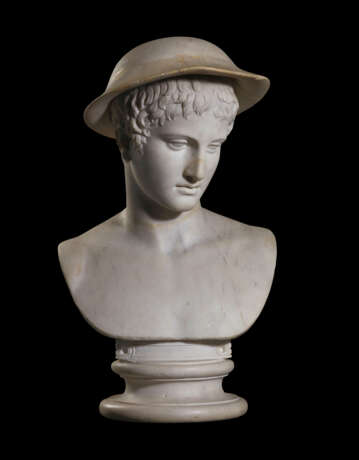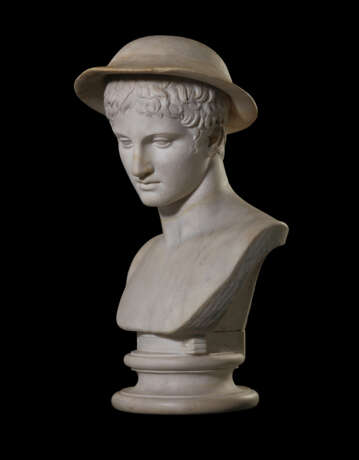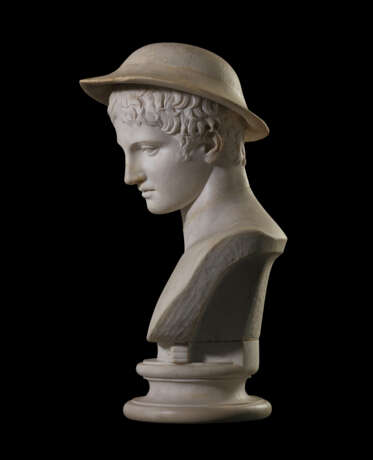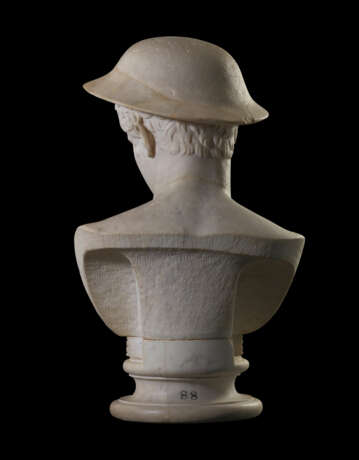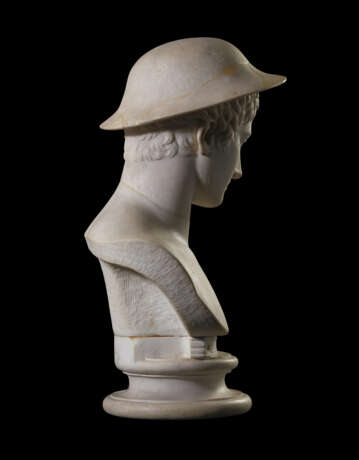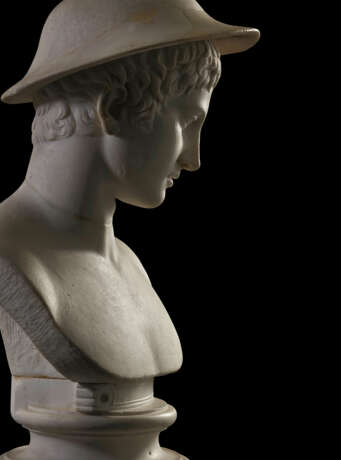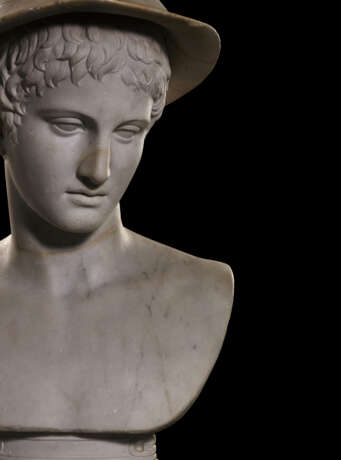ID 791838
Lot 25 | A ROMAN MARBLE HEAD OF HERMES
Estimate value
£ 3 000 000 – 5 000 000
CIRCA 120-140 A.D.
Provenance
Gavin Hamilton (1723-1798), Rome, found at the Pantanello at Hadrian's Villa in November 1769.
Sir William Petty Fitzmaurice (1737-1805), 2nd Earl of Shelburne and later 1st Marquess of Lansdowne, Lansdowne House, acquired from the above as a 'Bust of Mercury' in 1771 for £55 and mentioned in a letter of 1st November 1771.
Catalogue of the Celebrated Collection of Ancient Marbles the Property of the Most Honourable The Marquess of Lansdowne, Christie, Manson & Woods, London, 5th March 1930, lot 16.
By direct descent in the Lansdowne Family at Bowood.
Literature
Letter from Hamilton to Lord Shelburne, 1 November 1771, reproduced in I. Bignamini & C. Hornsby, Digging and Dealing in Eighteenth-Century Rome, vol. II, London, 2010, p. 21, no. 28.
Specimens Of Antient Sculpture, Aegyptian, Etruscan, Greek, And Roman: Selected From Different Collections In Great Britain, by the Society Of Dilettanti, London, vol. I, 1809, pl. LI.
Catalogue of the Lansdowne Marbles, 1810, lot 62.
J. Dallaway, Of Statuary and Sculpture Among the Antients with Some Account of Specimens Preserved in England, London, 1816, p. 343.
F. G. Welker, Das Akademische kunstmuseum zu Bonn, Bonn, 1841, p. 74, no. 123.
A. Jameson, Companion to the Most Celebrated Private Galleries of Art in London Containing Accurate Catalogues, Arranged Alphabetically, for Immediate Reference, Each Preceded by an Historical and Critical Introduction, Harvard, 1844, p. 337.
J. A. Overbeck, Kunstarchaeologische Vorlesungen im Anschluss an das akademische kunstmuseum in Bonn, Brunswick, 1853, p. 103, no. 155.
G. Waagen,Treasures of art in Great Britain, vol. II, 1854, p. 150.
A. Michaelis, 'Die Sammlung Lansdowne', in Archaeologischer Anzeiger 20, 1862, p. 338.
R. Kekule, Das Akademische kunstmuseum zu Bonn, Bonn, 1872, p. 77, no. 293.
A. Michaelis, ‘Lansdowne House‘, in Archäologische Zeitung 32, 1875, p. 39, no. 55.
A. Michaelis, Ancient Marbles in Great Britain, Cambridge, 1882, p. 467, no. 88.
A. J. C. Hare, Walks in London, vol. II, London, 1883, p. 97.
A.H. Smith, A Catalogue of the Ancient Marbles at Lansdowne House based upon the work of Adolf Michaelis. With an Appendix containing Original Documents relating to the Collection, London, 1889, p. 43, no. 88.
Jahrbuch des Kaiserlich Deutschen Archaeologischen Instituts 5, Berlin, 1891, p. 161, no. 88.
A. Kalkmann, Die Proportionen des Gesichts in der Griechischen Kunst, Berlin, 1893, p. 96, no.69.
A. Furtwängler, Meisterwerke der Griechischen Plastik, Berlin, 1893, p. 506.
H. Winnefeld, 'Die Villa des Hadrian bei Tivoli', in Jahrbuch des Kaiserlich Deutschen Archaeologischen Instituts 3, 1895, p. 158.
P. Gusman, La Villa Impériale de Tibur (Villa Hadriana), Paris, 1904, p. 274.
A. H. Smith, 'The Sculptures in Lansdowne House', in The Burlington Magazine for Connoisseurs 6 No. 22, January 1905, p. 277, pl. II.
E. B. Chancellor, The Private Palaces of London, London, 1908, p. 281.
D. Brucciani, Catalogue of Casts for Schools, London, 1914, p. 13, no. 2885.
K. Baedeker, London and its Environs, London, 1923, no. 88.
P. Arndt & W. Amelung, Photographische Einzelaufnahmen Antiker Sculpturen, Munich, 1893–1947, no. 4918.
C. C. Vermeule and D. von Bothmer, 'Notes on a New Edition of Michaelis', in American Journal of Archaeology, vol. 59⁄2, 1955, p. 131, no. 88.
A. Linfert, Von Polyklet zu Lysipp, Cologne, 1966, p. 254.
M. Clarke and N. Penny, The Arrogant Connoisseur: Richard Payne Knight 1751-1824, Manchester, 1982, p. 140, no. 51.
J. Raeder, 'Die statuarische Ausstattung der Villa Hadriana bei tivoli,' in Europäische Hochschulschriften XXXVIII, Archaeologie Bd. 4, Frankfurt am Main, Bern, 1983, 45-6, I, 22 and 223.
K. Fittschen, Verzeichnis der Gipsabgüsse des Archäologischen Instituts der Georg-August-Universität Göttingen: Bestand 1767-1989, Gottingen, 1990, p. 100, no. A402.
E. Simon, 'Mercurius', Lexicon Iconographicum Mythologiae Classicae, VI, 1992, p. 506, no. 20.
J. Bauer and W. Geominy, Gips nicht mehr. Abgüsse als Letzte Zeugen Antiker Kunst, Bonn, 2000, p. 123, no. 11.
I. Bignamini & C. Hornsby, Digging and Dealing in eighteenth-century Rome, London, 2010, vol. I, p. 160 and 164, no. 15 and vol II, p. 26 no. 40.
E. Angelicoussis, Reconstructing the Lansdowne Collection of Classical Marbles, Munich, 2017, pp. 160-165, no. 21.
Arachne. Datenbank und kulturelle Archive des Forschungsarchiv für Antike Plastik Köln und des Deutsches Archäologisches Instituts, no. 51167.
| Medium: | Marble, Stone |
|---|---|
| Art style: | Ancient Art |
| Place of origin: | Italy, Europe, Roman Empire |
| Auction house category: | Ancient Art & Antiquities, Sculptures, Statues & Figures |
| Medium: | Marble, Stone |
|---|---|
| Art style: | Ancient Art |
| Place of origin: | Italy, Europe, Roman Empire |
| Auction house category: | Ancient Art & Antiquities, Sculptures, Statues & Figures |
| Address of auction |
CHRISTIE'S 8 King Street, St. James's SW1Y 6QT London United Kingdom | |
|---|---|---|
| Preview |
| |
| Phone | +44 (0)20 7839 9060 | |
| Buyer Premium | see on Website | |
| Conditions of purchase | Conditions of purchase |
